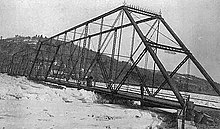Callicoon Bridge
[3] In addition to the river, it crosses the flood plain on its eastern bank in New York created by the confluence of the Delaware and Callicoon Creek, one of its major tributaries in the area, just downstream.
Traffic crosses on an asphalt deck 25 feet (7.6 m) wide, enough to hold one lane in each direction as well as a concrete sidewalk and steel guardrails.
Half of the bridge's span crosses an extensive flood plain on the New York side resulting from the confluence of the Delaware and Callicoon Creek immediately downstream.
[4] On either side are small settlements typical of the sparsely populated regions of the states the Upper Delaware divides; as it is not along a major through route between them, the bridge carries on average 1,322 vehicles a day.
The New York approach goes through the unincorporated hamlet of Callicoon, part of the town of Delaware which has a small built-up downtown with many historic buildings.
On southbound 97, a sign directs Pennsylvania-bound drivers to bear off the road at Fremont Street, the north end of Route 133, which they then follow to the spur over the grade crossing.
[6] It grew in population, and by 1875 the local lumber industry reached its peak, with over 3,000 rafts leaving the village for markets and mills downriver.
Tanneries set up shop, drawn by the abundant Eastern Hemlock in the woods on both sides of the river, and a paper mill flourished until it burned down in 1879.
While sentiment was heavily in favor of erecting one, enthusiasm dimmed as it was realized what that would entail—buying land for the approaches on both sides, getting both New York and Pennsylvania to approve the project, selecting a design and hiring a contractor to build the bridge.
It remained open while the current structure was constructed, slightly downstream, by the Binghamton Bridge and Foundation Company starting in 1961.
